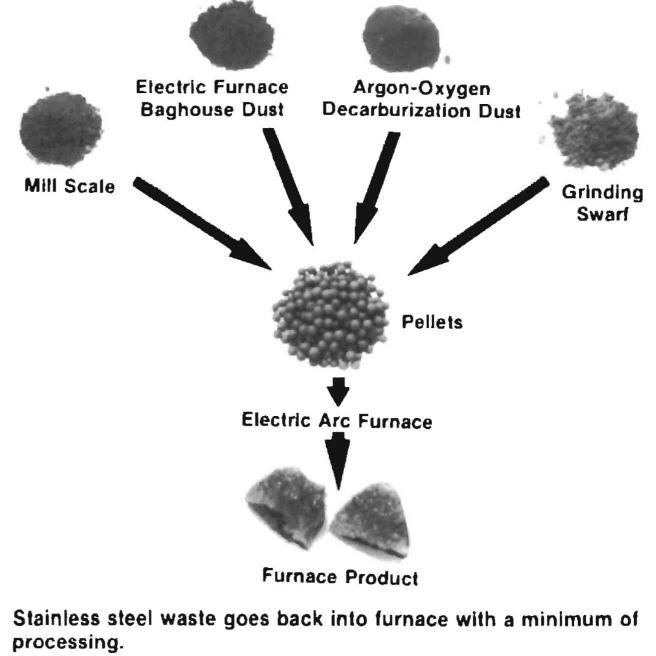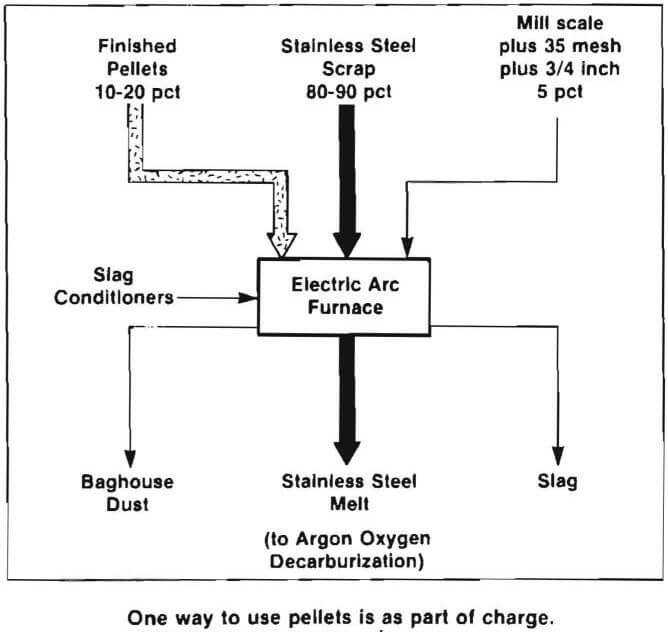Table of Contents
To reuse chromium, nickel, and molybdenum now lost in stainless and specialty steel-making wastes, and simultaneously to overcome the current environmental problem resulting from landfilling these wastes. A variety of stainless and specialty steelmaking wastes are agglomerated and recharged into the plant’s electric arc furnaces.
How It Works
Stainless and specialty steel-making wastes such as bag-house dust from the electric arc furnace, dust from the argon-oxygen decarburization unit, grinding swarf, and mill scale are blended in proportion to the ratio in which they are generated. Next they are agglomerated on a pelletizer with an addition of a small amount of carbonaceous reducing agent, and air-dried in preparation for being recharged into the furnace. Some mixtures of wastes tested in the laboratory required the addition of binders and/or the use of ovens in lieu of air-drying to produce sufficient pellet strength. Although the optimal maximum particle size of wastes being pelletized is 35 mesh, somewhat larger particle sizes were satisfactorily pelletized during in-plant tests. The photograph shows a typical mixture of wastes and the pellets made from them.

The pellets made from wastes can be charged to the electric arc furnace as 5 to 20 percent of the charge, depending on their rate of generation. The diagram shows the materials input and output to a furnace using this method. An alternate method for using these wastes is to make a heat of waste pellets alone and tap a master-alloy ingot suitable for subsequent charging to a production heat. Use of this method depends on furnace and labor availability, as well as scheduling priorities.
Recycling stainless steel and specialty steel wastes in the steelmaking plant offers several benefits. Buildup and extensive storage can be eliminated without introducing the problems of landfilling potentially hazardous substances. Recycling also has potential for reducing the producer’s cost by not wasting expensive metals. It could also help reduce United States demand for imports of chromium and other critical metals.
Test Results
After the initial laboratory tests indicated the potential of this Bureau-developed procedure, a series of larger-scale industrial tests were made at Joslyn Stainless Steels in Ft. Wayne, Indiana. The tests were made in the 18-ton electric arc furnaces of the melt shop. During these tests, 14 to 19 percent of the charge consisted of pelletized wastes generated in the Joslyn plant. All of these trials produced successful commercial heats of type 316 stainless steel.
In the tests, chromium recoveries up to 90 percent were indicated and nickel, iron, and molybdenum recoveries of up to 99 percent were indicated. More importantly, no additional energy or manpower was required for the waste-product heats. Furthermore, the plant management was relieved of the nagging and costly problem of disposing of these wastes. As a result of these tests, the Board of Directors of Joslyn Stainless Steels has appropriated funds for installing aggolmeration equipment to process their wastes on a permanent basis.

This method was developed at the Bureau of Mines Rolla Research Center, and the project officers in charge of the research are L.W. Higley and L A. Neumeier.
